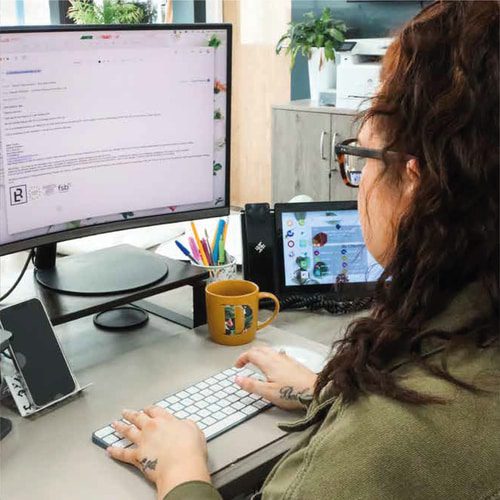
Effective Web Design Techniques You Need To Use
As a web designer, it is important to have the relevant skills. However, there are so many techniques and options out there that it can be difficult to find the right one. Here are some tips on which skills and techniques you should apply in a website design.
Prototyping
This is the process of creating a basic design or framework for your website. It can be as simple as sketching out a few ideas on paper or using a wireframing tool to get a basic idea of the layout and structure. The point of this is to have something to show clients or stakeholders so they can provide feedback early on. It also helps to prevent scope creep later on in the project.
R. Yokoyama, a Business Analyst at XPO Logistics, stated that they use prototypes for various aspects such as UX cognitive testing, stakeholder requirements, and clients’ feedback analysis. She further noted that it simplifies the process of visualizing a solution for stakeholders, which makes projects run more smoothly overall.
Some of the best tools and software for prototyping a website include:
- InVision is a useful tool for 1) creating high-fidelity prototypes, 2) interactive prototyping with motions, and 3) developing layouts with good hierarchy options.
- With the Marvel wireframe app, you can bring your ideas to life through design or by uploading your work from Sketch or Photoshop. You can also grab comments and sync your prototype with cloud storage.
- If you’re not a big fan of coding or if you want to minimize the amount of code writing, Webflow is definitely helpful! It focuses on actually developing your custom designs without any coding.
- Mockup Builder is a powerful prototyping tool that lets you quickly and easily convert your sketches into prototypes. With features like background colour changes, image resizing, and various device templates, Mockup Builder makes it easy to create high-quality prototypes.
- Vectr is the perfect tool for app prototyping on Mac and Windows, with simple sharing and collaboration features. This tool also offers clickable mockups, offline desktop apps, and more.
Boyle’s Law holds that you should never enter a meeting without a prototype. This practice not only improves internal communication but also allows designers and programmers to connect with one another.
Keep it simple
In order to create an effective and user-friendly website, it is important to focus on the usability and utility of the site. This means eliminating any elements that are not critical to users, keeping things simple and easy to understand, and making sure key pages are visually obvious.
Additionally, since mobile users now make up a large percentage of traffic for many platforms, it is essential to take a “mobile first” approach in design. This means designing for the smallest screen first, then applying the same design to larger screens.
Call to action buttons.
Designers need to pay attention to the call-to-action buttons on their websites and apps, as these buttons play a crucial role in motivating users to purchase products. The placement of these buttons is important for maximum effectiveness, and it’s worth experimenting with different colours and designs to see what works best for your audience.
For example, Dropbox uses a common design with an open space, and its bright call to action button immediately captures users’ attention. Another effective strategy is booking.com’s use of scarcity, which tells users how many other people are viewing the same hotel room. This encourages them to take action before it’s too late.
Unique style and typography
One way to make your website stand out from the rest is to focus on creating a unique style. This can be achieved through the use of custom typography, images, and colours. By doing this, you’ll be able to create a site that looks different from the others and reflects your brand’s personality.
Quality typography is essential for any brand, as it helps users easily recognize your company from competitors. Good typography makes decisions easier for the user and should be “transparent” so that the reader’s attention is focused on the content. You can also make sure to use a typeface that works well in different sizes and avoid being too creative with your style lest you confuse readers.
It’s important to use typography effectively so that users can easily read the content on your site. This means choosing the right font size, line height, and contrast. For example, sans-serif fonts are generally more legible than serif fonts, and lower contrast can make the text more difficult to read. By following these tips, you can create a website with a unique style that is also easy to read.
Layout and whitespace
The layout of your website is important for both usability and aesthetics. Users should be able to easily find what they’re looking for, and the overall design should be pleasing to the eye. Common mistake designers make is cramming too much information into one space, which can make things feel cluttered and difficult to navigate.
Instead, it’s important to use whitespace effectively to create a more open and airy feel. This will help users focus on the most important elements on the page and make your site more visually appealing. In general, it’s best to use a simple layout with plenty of whitespaces so that users can easily find what they’re looking for.
Responsive design
Another important aspect of website design is responsive design, which ensures that your site looks good on all devices. This is especially important in today’s market, as more and more people are using mobile devices to access the internet.
There are a few ways to achieve responsive design, but one common method is using media queries. Media queries allow you to create different stylesheets for different screen sizes to optimize your site for each device. This is essential in creating a user-friendly website that looks great on all devices.
Final thoughts
Creating a user-friendly website is essential for any business in today’s market. By following the tips above, you can make sure that your site is easy to navigate, visually appealing, and responsive. By designing a quality website, you’ll be able to improve your brand’s image and attract more customers.




